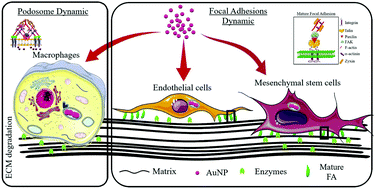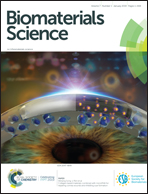Disturbance of adhesomes by gold nanoparticles reveals a size- and cell type-bias†
Abstract
Gold nanoparticles (AuNP) have been thoroughly studied as multifunctional theranosis agents for cell imaging and cancer therapy as well as sensors due to their tunable physical and chemical properties. Although AuNP have proved to be safe in a wide concentration range, yet other important biological effects can arise in the sublethal window of treatment. This is especially pivotal to understand how AuNP can affect cell biology when labeling steps are needed for cell tracking in vivo, as nanoparticle loading can affect cell migratory/invasion ability, a function mediated by filamentous actin-rich nanometric structures collectively called adhesomes. It is noteworthy that, although numerous research studies have addressed the cell response to AuNP loading, yet none of them focuses on adhesome dynamics as a target of intracellular pathways affected by AuNP. We intend to study the collective dynamics of adhesive F-actin rich structures upon AuNP treatment as an approach to understand the complex AuNP-triggered modulation of migration/invasion related cellular functions. We demonstrated that citrate-coated spherical AuNP of different sizes (3, 11, 16, 30 and 40 nm) disturbed podosome-forming rosettes and the resulting extracellular matrix (ECM) degradation in a murine macrophage model depending on core size. This phenomenon was accompanied by a reduction in metalloproteinase MMP2 and an increment in metalloproteinase inhibitors, TIMP-1/2 and SerpinE1. We also found that AuNP treatment has opposite effects on focal adhesions (FA) in endothelial and mesenchymal stem cells. While endothelial cells reduced their mature FA number and ECM degradation rate upon AuNP treatment, mouse mesenchymal stem cells increased the number and size of mature FA and, therefore, the ECM degradation rate. Overall, AuNP appear to disturb adhesive structures and therefore migratory/invasive cell functions measured as ECM degradation ability, providing new insights into AuNP–cell interaction depending on cell type.



 Please wait while we load your content...
Please wait while we load your content...